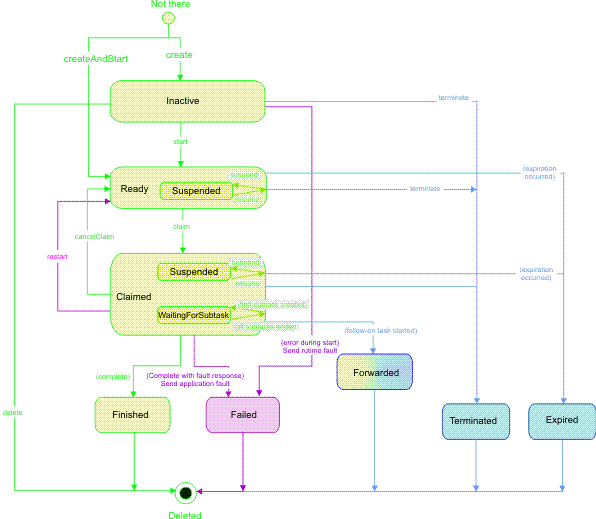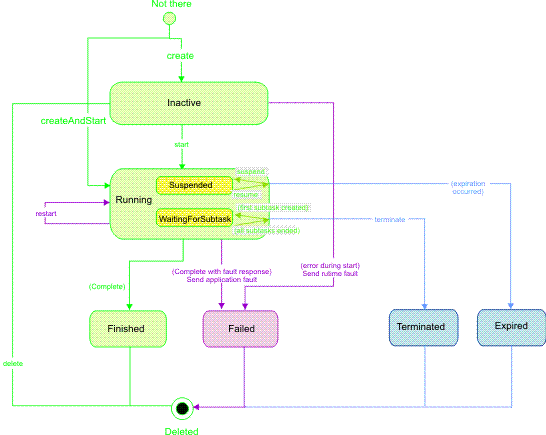IBM BPM, V8.0.1, All platforms > Get started with IBM BPM > Key concepts > BPEL processes and human tasks > Human tasks overview > Lifecycle of human tasks
State transition diagrams for to-do tasks
To-do tasks are created automatically by a client application or calling component. They support people when they perform work as part of a BPEL process (inline tasks), or implement a web service that is publicly available (stand-alone task). During the lifecycle of a to-do task, certain interactions are possible only in certain task states, and these interactions, in turn, influence the state of the task.
The state transitions that occur during the lifecycle of the task also depend on whether the task has single ownership or parallel ownership.
To-do tasks with single ownership
The following diagram shows the state transitions that can occur during the lifecycle of to-do tasks that have a single owner. For stand-alone to-do tasks, it assumes that the autonomy attribute of the task is set to peer.

After the task is created, it is put into the inactive state. In this state you can update task properties or set custom properties, for example, to change the duration until the task is due, expires, or is deleted. To work on a to-do task, it must be started.
After the task is started, it is put into the ready state. In this state the task waits for one of the potential owners to claim it and perform the work associated with this task. In this state, the following exceptional events can occur:
- The task is escalated if it is not claimed or completed in time, or an authorized user triggers the escalation manually. The task is put into the escalated substate, and it stays in this substate for the rest of the task lifecycle.
- The task can be suspended manually. It is put into the suspended substate. Most actions on the task are blocked in this state. It can be resumed manually, or automatically by a timer that is set with the suspend action.
- The task can expire. This state change ends the task.
- To reschedule a task when it is due, expires, or is deleted, the originator, starter or administrator of the task can edit the appropriate property for the duration or point in time.
- The task can be terminated manually using the terminate action. This state change ends the task.
In the normal task flow, one of the potential owners claims the task, and becomes the owner. The task is put into the claimed state and the owner and the editors can work on it. When tasks are in the claimed state, task owners can take the following actions:
- If they need support for their work, they can delegate pieces of work using subtasks. These subtasks can be either collaboration tasks or invocation tasks. The parent task then enters the waiting-for-subtask substate and remains in this state until all of its subtasks reach an end state. The parent task can be suspended while waiting for subtasks, but it cannot be completed and the claim cannot be canceled. If the parent task is suspended, all of its subtasks are also suspended.
- If they want to delegate the completion of the work to someone else, they can create, for example, a collaboration task as a follow-on task to complete the work. The parent task is put into the forwarded end state.
- If they want to delegate the overall responsibility for tasks, they can transfer owner work items to another potential owner, or an administrator.
- If they want to give up ownership of a task, they can cancel the claim of the task. The task is put into the ready state again, and it can be claimed by one of the potential owners. If that if the claim of the task is canceled, this action does not affect the due time or expiration time of the task, or the timing of the escalations.
In the claimed state, the following exceptional events can occur:
- The task is escalated if it is not completed in time or if it waits too long for subtasks to complete. An authorized user can also trigger the escalation manually. The task is put into the escalated substate.
- The task can be suspended manually. It is put into the suspended substate. Most actions on the task are blocked in this state. It can be resumed manually, or automatically by a timer that is set with the suspend action. Alternatively, when the timer expires, the claim on the task is canceled and it is put into the ready state again.
- The task can expire. This is a state change that ends the task.
- To reschedule a task when it is due, expires, or is deleted, the originator, starter or administrator of the task can edit the appropriate property for the duration or point in time.
- The task can be terminated manually using the terminate action. This is a state change that ends the task.
- The task can be restarted. The task is put back into the ready state. If the task has substates, they are canceled. Escalations associated with the task are reset to the inactive state, and begin their normal lifecycle. If the task has subtasks, these are terminated and deleted.
When the work is finished on a task, the owner completes the task. The task is then put into the finished state if it completes successfully, or the failed state if an error occurs.
The failed, terminated, finished, and expired states are end states in which work cannot be performed. If the task template specifies automatic deletion, the task is either deleted immediately, or after the deletion timer expires. Without automatic deletion, the task remains in its end state until it is explicitly deleted. When the parent task is deleted, its subtasks and follow-on tasks are also deleted.
The forwarded state indicates that work is still required on the follow-on task. Automatic deletion of the parent task applies as soon as the follow-on task reaches an end state. Without automatic deletion, both the parent and the follow-on task remain in their states until the parent task is explicitly deleted. When the parent task is deleted, the follow-on task is also deleted.
Some additional rules apply to inline to-do tasks. Inline tasks are an integral part of the BPEL process and thus their lifecycle is controlled by the process lifecycle:
- The task is created and started implicitly by the BPEL process.
- The task is represented in the BPEL process by a human task activity. Both the task and the activity have the same state, for example, when that task is in the ready state, the human task activity is in the ready state too. The human task activity does not reflect the forwarded state or the task substates.
- If the inline task has subtasks, the human task activity is not aware of them, and it waits in the claimed state until the parent task completes.
- If the inline task has follow-on tasks, the human task activity is not aware of them, and it waits in the claimed state until the follow-on task completes.
- Inline to-do tasks have no duration until expiration and cannot be terminated manually. Both expiration and termination are controlled by the human task activity or the BPEL process.
- The tasks are deleted with the BPEL process. They cannot be deleted manually, or have a duration until deletion.
To-do tasks with parallel ownership
The following diagram shows the state transitions that can occur during the lifecycle of to-do tasks with parallel ownership.

The parent task cannot be claimed or manually completed. The parent task goes into the running state and stays there until its completion condition becomes true, or expiration is reached.
Related concepts:
To-do tasks and collaboration tasks with parallel ownership
Changes to the expiration, deletion, and due times for tasks at run time
Related information:
Lifecycle of stand-alone human tasks that are invoked by a BPEL process